Related Research Articles

Alessandro Bonvicino, more commonly known as Moretto, or in Italian Il Moretto da Brescia, was an Italian Renaissance painter from Brescia, where he also mostly worked. His dated works span the period from 1524 to 1554, but he was already described as a master in 1516. He was mainly a painter of altarpieces that tend towards sedateness, mostly for churches in and around Brescia, but also in Bergamo, Milan, Verona, and Asola; many remain in the churches they were painted for. The majority of these are on canvas, but a considerable number, including some large pieces, are created on wood panels. There are only a few surviving drawings from the artist.
Supper at Emmaus is an event in the Gospel of Luke.

Giovanni Girolamo Savoldo, also called Girolamo da Brescia, was an Italian High Renaissance painter active mostly in Venice, although he also worked in other cities in northern Italy. He is noted for his subtle use of color and chiaroscuro, and for the sober realism of his works, which are mostly religious subjects, with a few portraits. His portraits are given interest by their accessories or settings; "some even look like extracts from larger narratives".
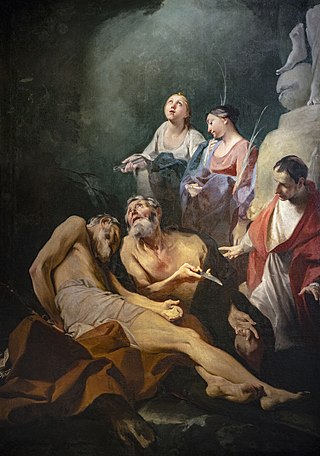
Federico Bencovich was a late Baroque painter from Dalmatia working in Italy. He is best known as Federico Bencovich or Federigo or Federighetto or Dalmatino. In modern Croatia he is known as Federiko Benković.

Ottavio Amigoni was an Italian painter of the Baroque period, active in Brescia. He was trained by Antonio Gandini. Among his masterpieces is a large fresco about the life of Sant'Alberto in the Carmelite church of Brescia, painted with Gandino's son, Bernardino.

The Pinacoteca Tosio Martinengo is a public art museum in Brescia, Lombardy, Italy.
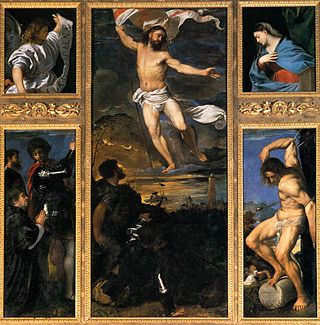
The Averoldi Polyptych, also known as the Averoldi Altarpiece, is a painting by the Italian Renaissance painter Titian, dating to 1520–1522, in the basilica church of Santi Nazaro e Celso in Brescia, northern Italy.

The church of Santa Maria dei Miracoli is located on Corso Martiri della Libertà in Brescia.

The church of Sant'Afra in Brescia, also known as the church of Sant'Afra in Sant'Eufemia, is located on Corso Magenta, near Piazzale Arnaldo.

The church of Santa Maria delle Grazie in Brescia is located on at the west end of Via Elia Capriolo, where it intersects with the Via delle Grazie. Built in the 16th century and remodeled in the 17th century, it still retains much of its artwork by major regional artists, including one of its three canvases by Moretto. The other two are now held at the Pinacoteca Tosio Martinengo. The interior is richly decorated in Baroque fashion. Adjacent to the church is the Sanctuary of Santa Maria delle Grazie, a neo-gothic work.
San Domenico is a Renaissance style, Roman Catholic church located on Via Amondi in Orzinuovi, Province of Brescia, in the region of Lombardy, Italy.

Salomé is an oil painting on canvas, by Moretto da Brescia, executed c. 1540. It is kept in the collection of the Pinacoteca Tosio Martinengo in Brescia.

Annunciation is a 1535–1540 oil on panel painting by Moretto da Brescia, now in the Pinacoteca Tosio Martinengo in Brescia, having been left to the city collection by count Paolo Tosio in 1832 – no previous owners are known. Its small dimensions mean it was probably painted for a home or clergy house rather than a church. Several replicas and copies are known, some of which are now lost.

Pentecost is an oil on canvas painting by Moretto da Brescia, executed c. 1543–1544, originally painted for San Giuseppe Church in Brescia and now in the city's Pinacoteca Tosio Martinengo.
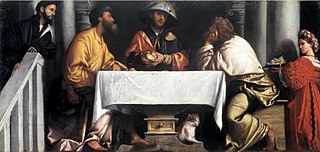
Supper at Emmaus is an oil on canvas painting by Moretto da Brescia, executed c. 1526, now in the Pinacoteca Tosio Martinengo in Brescia. It was originally painted for the Church of San Luca in the city, where it was first recorded in 1630 by Bernardino Faino, who saw it in the San Sebastiano chapel.

The Sant'Eufemia Altarpiece is a 1526-1530 oil on panel painting by Moretto da Brescia, originally on the high altar of Sant'Afra in Brescia and now in the Pinacoteca Tosio Martinengo in the town. The Sant'Afra Reliquary was also based on the painting. The painting's lower register shows saints Benedict of Nursia, Euphemia, Justina and Paterius.

The Luzzago Altarpiece is a 1542 oil on canvas painting by Moretto da Brescia, now in the Pinacoteca Tosio Martinengo in Brescia. It was recorded in San Giuseppe church in Brescia in 1630 and moved to its present home in 1868. In the lower register Michael the Archangel points the kneeling donor to the Madonna and Child above, whilst Francis of Assisi stands to the right with a cross.
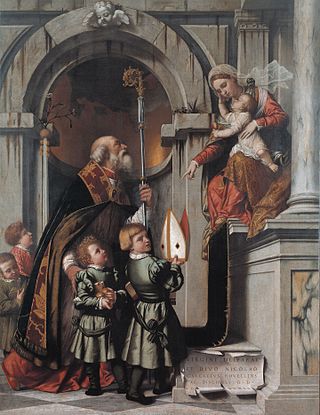
The Rovelli Altarpiece is a 1539 oil on canvas painting by Moretto da Brescia, which since 1899 has been in the Pinacoteca Tosio Martinengo in Brescia, Italy. Strongly influenced by Titian, it is named after the schoolmaster Galeazzo Rovelli who commissioned it for the church of Santa Maria dei Miracoli in Brescia in 1539, where it remained until being removed in the 19th century and replaced by a copy. Its composition was reused by Moroni in his Mystic Marriage of Saint Catherine in the 1560s.

St Anthony of Padua with Two Saints is a c. 1530 oil on canvas painting by Moretto da Brescia, now in the Pinacoteca Tosio Martinengo in Brescia. The other two saints shown are Antony the Great and Nicholas of Tolentino.
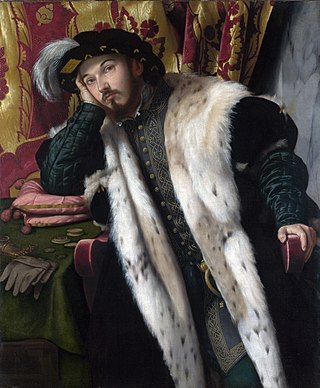
The Bergamasque and Brescian Renaissance is one of the main variations of Renaissance art in Italy. The importance of the two cities on the art scene only expanded from the 16th century onward, when foreign and local artists gave rise to an original synthesis of Lombard and Venetian modes, due in part to the two cities' particular geographical position: the last outpost of the Serenissima on the mainland for Bergamo and a disputed territory between Milan and Venice for Brescia.
References
- ↑ Pinacoteca Orzinuovi Archived 2015-02-16 at the Wayback Machine
- Nicoli Cristiani, Federico (1807). Della Vita delle pitture di Lattanzio Gambara; Memorie Storiche aggiuntevi brevi notizie intorno a' più celebri ed eccelenti pittori Bresciani. Spinelli e Valgiti, Brescia. pp. 169.